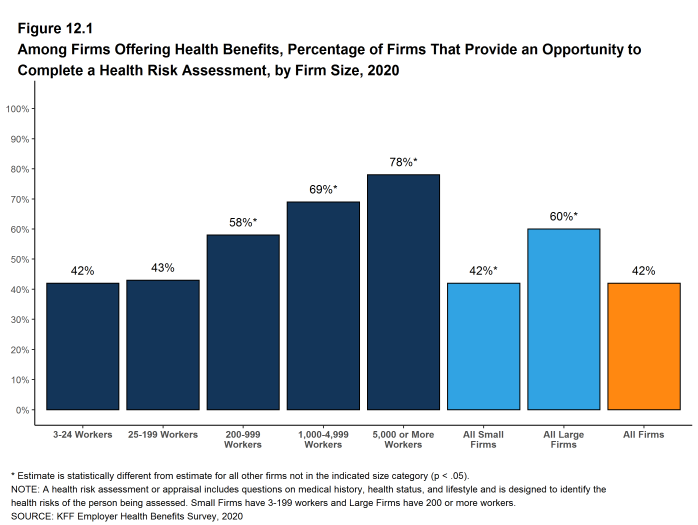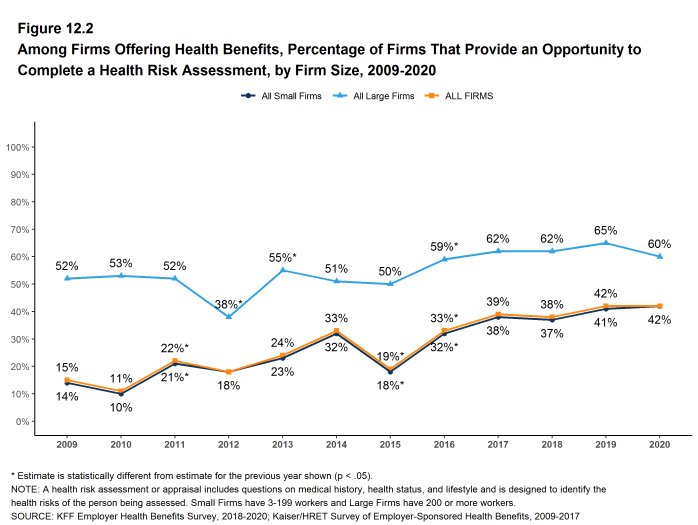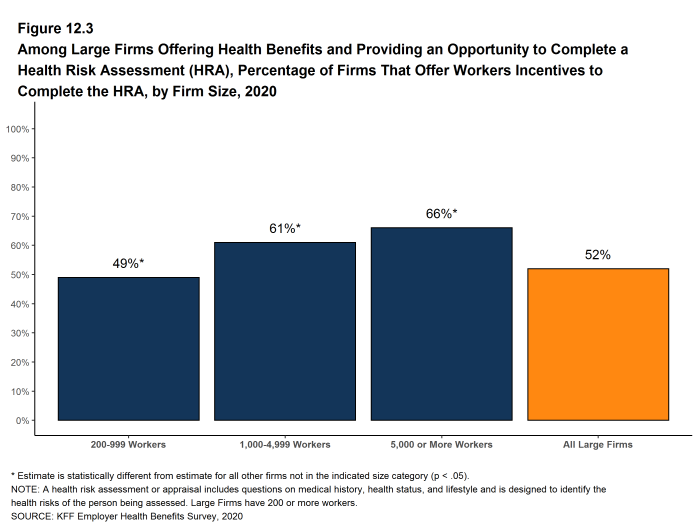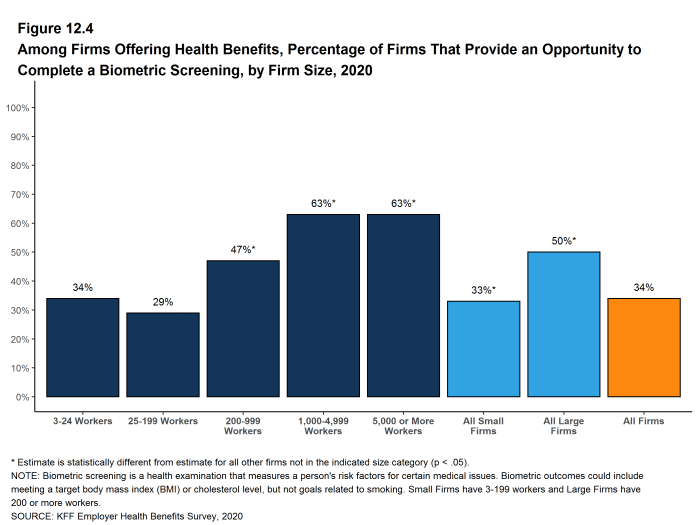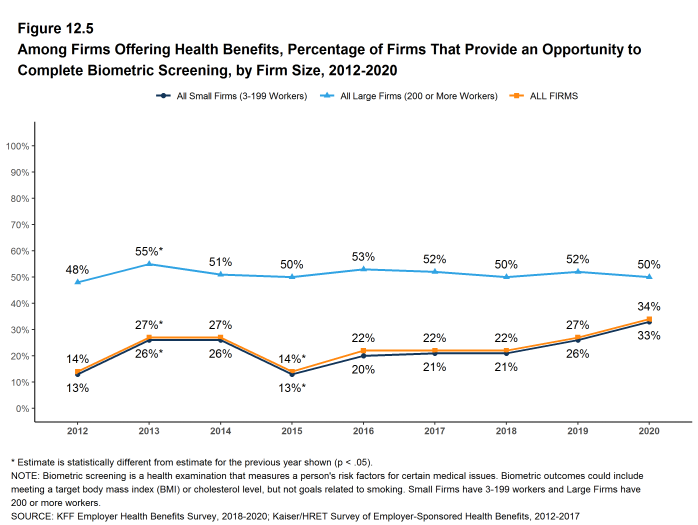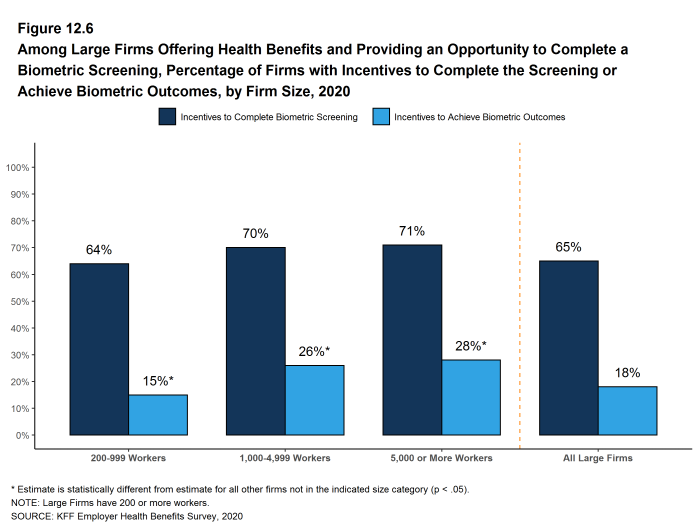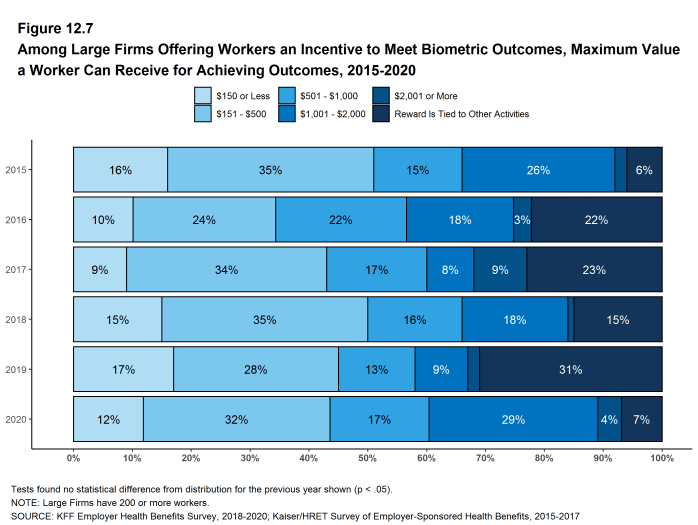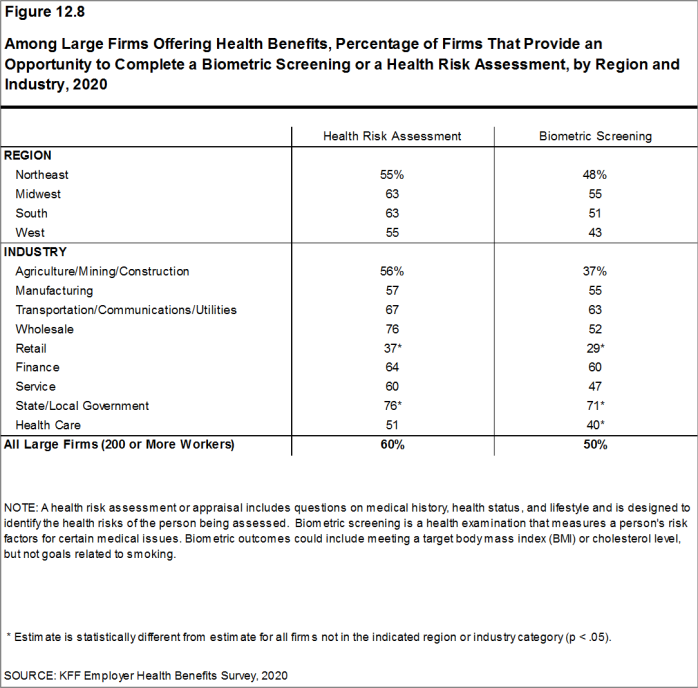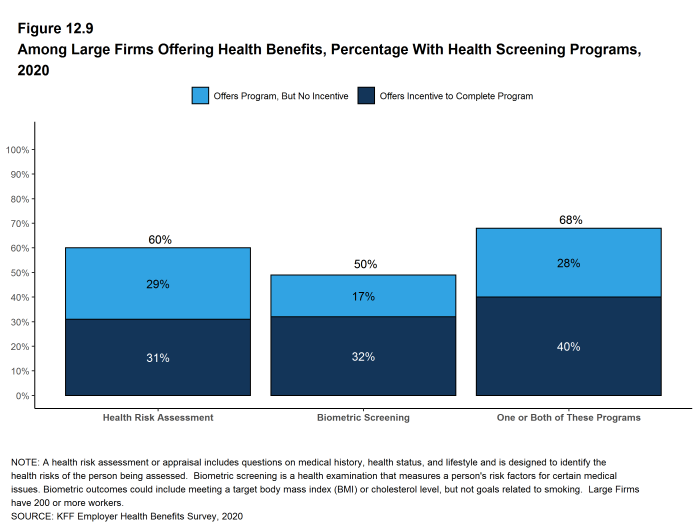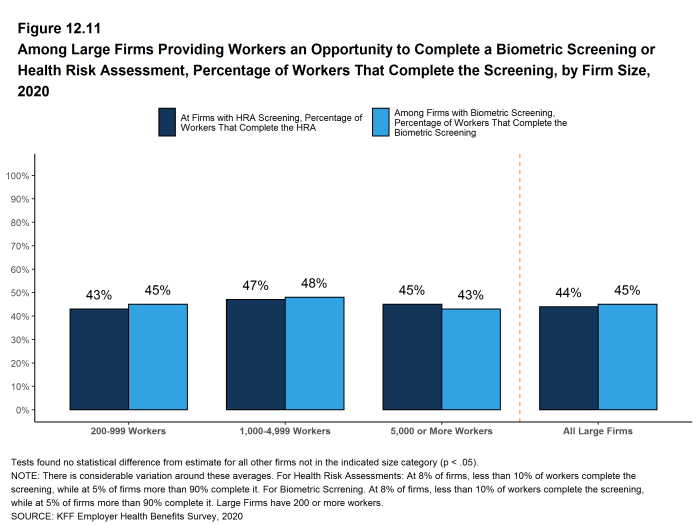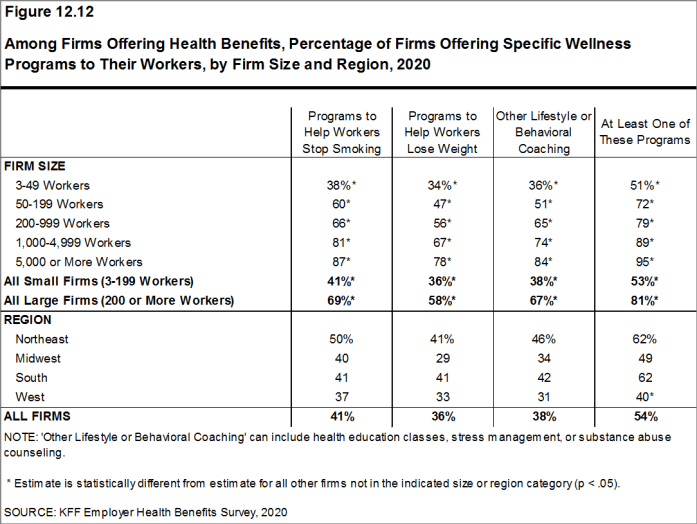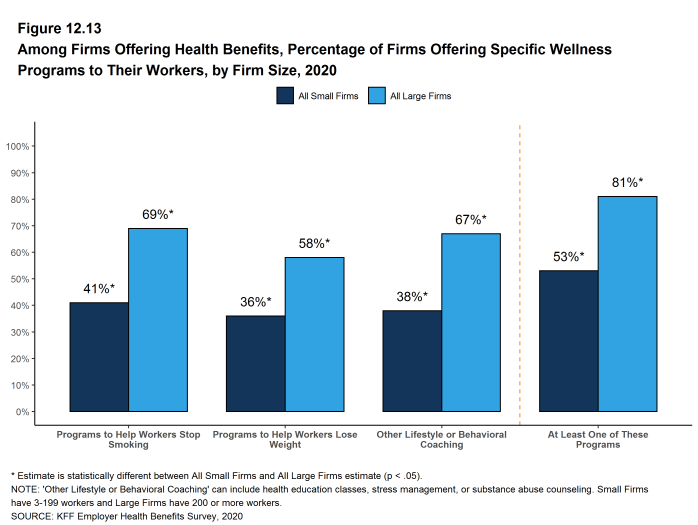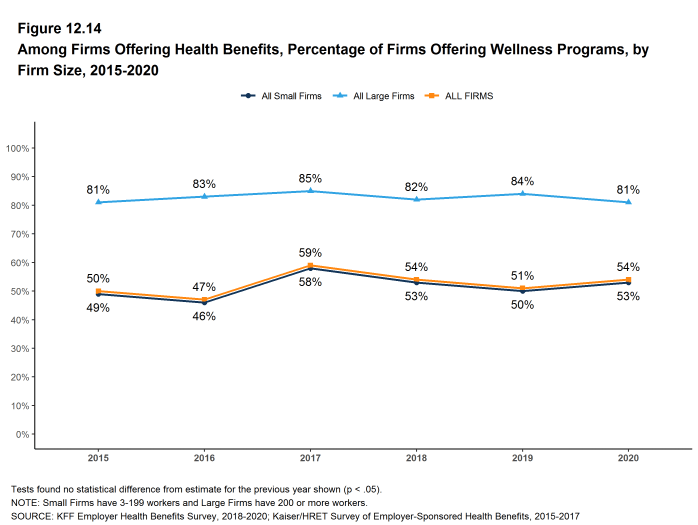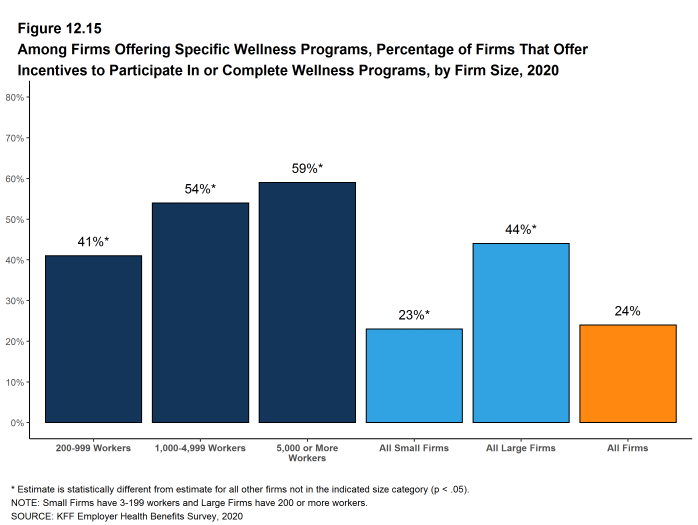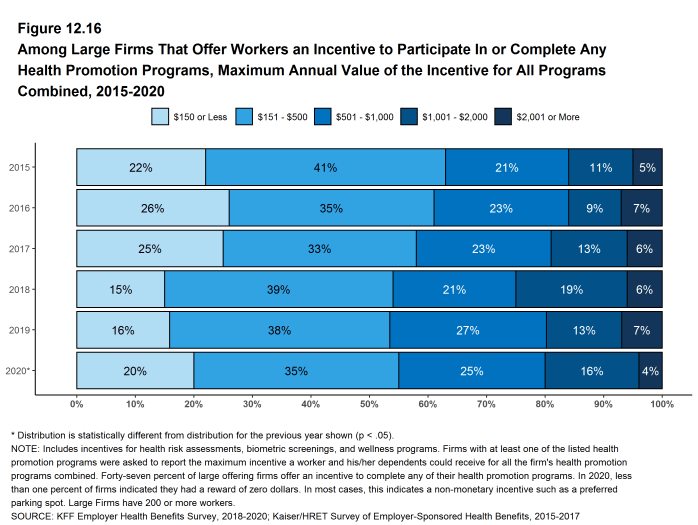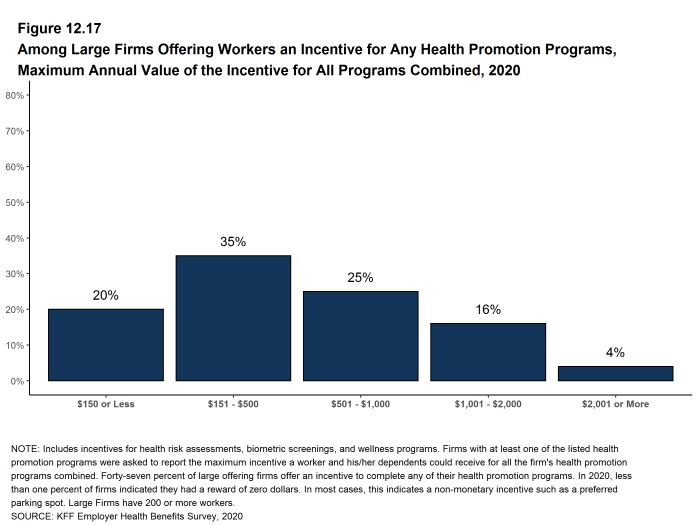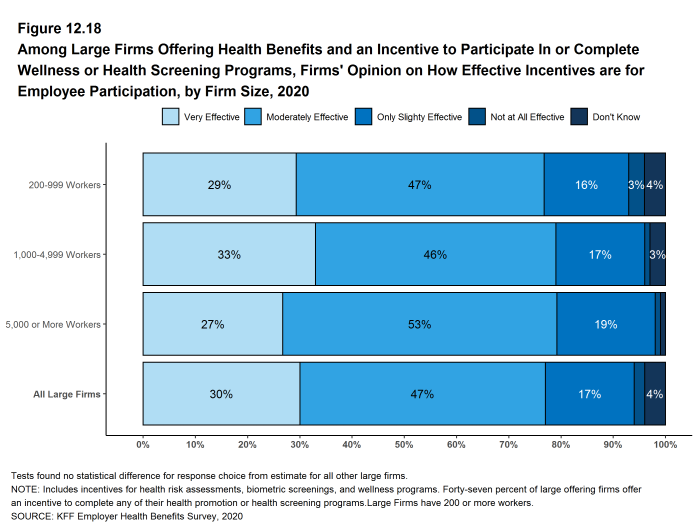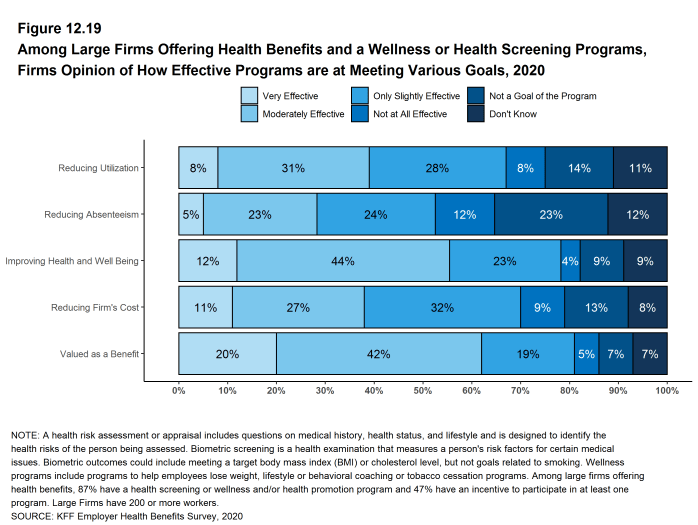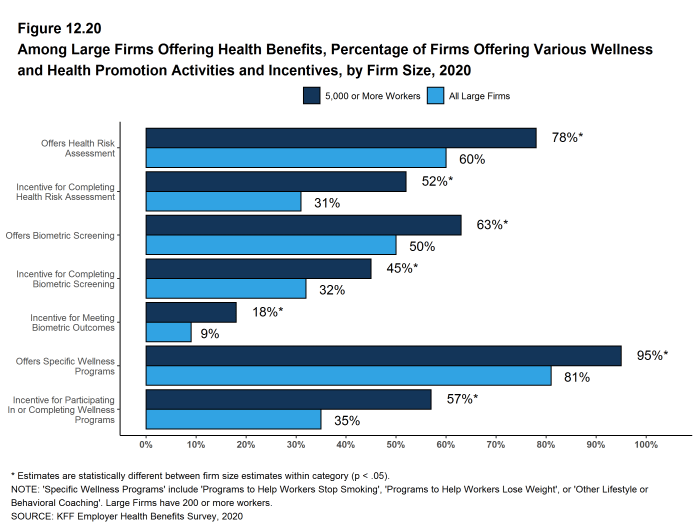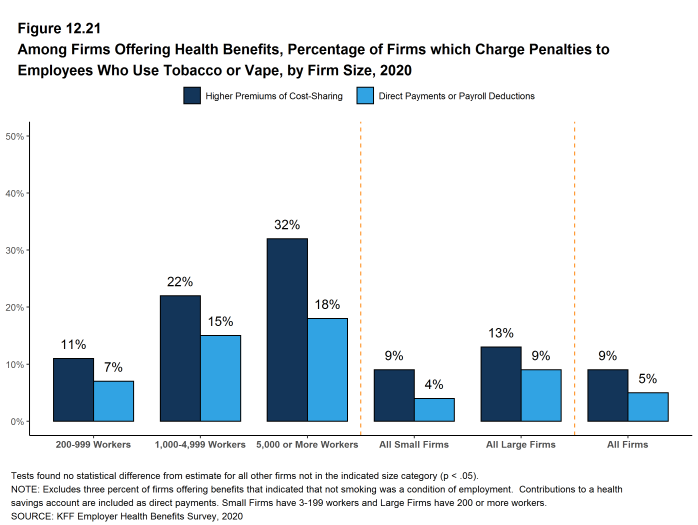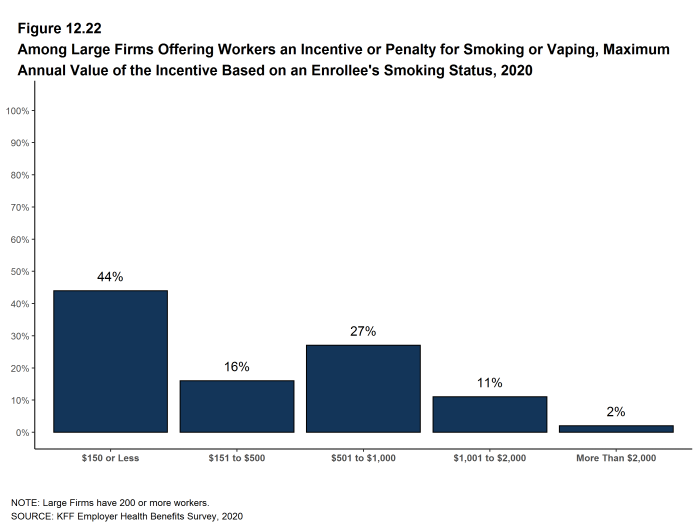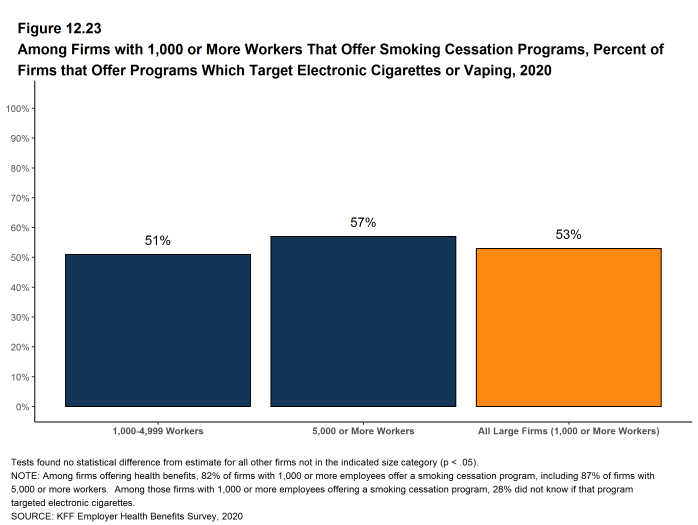2020 Employer Health Benefits Survey
Section 12: Health Screening and Health Promotion and Wellness Programs
Most firms offer some form of wellness program to help workers and family members identify health issues and manage chronic conditions. Many employers believe that improving the health of their workers and their family members can improve morale and productivity, as well as reduce health care costs.
In addition to offering wellness programs, a majority of large firms now offer health screening programs, including health risk assessments, which are questionnaires asking workers about lifestyle, stress, or physical health, and biometric screening, which we define as in-person health examinations conducted by a medical professional. Firms and insurers may use the health information collected during screenings to target wellness offerings or other health services to workers with certain conditions or behaviors. Some firms have incentive programs that reward or penalize workers for different activities, including participating in wellness programs or completing health screenings.
Among large firms offering health benefits in 2020, 60% offer workers the opportunity to complete a health risk assessment, 50% offer workers the opportunity to complete a biometric screening, and 81% offer workers one or more wellness programs, such as programs to help them stop smoking or lose weight, or programs that offer lifestyle and behavioral coaching. Substantial shares of these large firms provide incentives for workers to participate in or complete the programs.
Only firms offering health benefits were asked about their wellness and health promotion programs.
Employers have been and continue to deal with the coronavirus pandemic, including by modifying wellness and screening programs and employee assistance programs. For example, some employees may not be available for health screening or may not be able to participate in wellness-related programs. Some employers may have chosen to modify or suspend financial incentives due to potential difficulties with employees achieving compliance. Due to the timing of the survey, we were not able to include questions about how employers may have adapted their health plans and employee assistance programs to address some of the impacts of the epidemic.
HEALTH RISK ASSESSMENTS
Many firms provide workers the opportunity to complete a health risk assessment to identify potential health issues. Health risk assessments generally include questions about medical history, health status, and lifestyle. At small firms, health risk assessments are often administered by an insurer.
- Among firms offering health benefits, 42% of small firms and 60% of large firms provide workers the opportunity to complete a health risk assessment [Figure 12.1]. These percentages are similar to the corresponding percentages for 2019 (41% for small firms and 65% for large firms) [Figure 12.2].
- Some firms offer incentives to encourage workers to complete a health risk assessment.
- Among large firms that offer a health risk assessment, 52% offer workers an incentive to complete the assessment [Figure 12.3].
Figure 12.1: Among Firms Offering Health Benefits, Percentage of Firms That Provide an Opportunity to Complete a Health Risk Assessment, by Firm Size, 2020
Figure 12.2: Among Firms Offering Health Benefits, Percentage of Firms That Provide an Opportunity to Complete a Health Risk Assessment, by Firm Size, 2009-2020
BIOMETRIC SCREENING
Biometric screening is a health examination that measures a person’s risk factors (such as cholesterol, blood pressure, and body mass index (BMI)) for certain medical issues. A biometric outcome involves assessing whether the person meets specified health targets related to certain risk factors, such as meeting a target BMI or cholesterol level. As defined by this survey, goals related to smoking are not included in the biometric screening questions.
- Among firms offering health benefits, 33% of small firms and 50% of large firms provide workers the opportunity to complete a biometric screening [Figure 12.4]. These percentages are similar to 2019 (26% and 52%) [Figure 12.5].
- Some firms offer incentives to encourage workers to complete the biometric screening.
- Among firms with biometric screening programs, 17% of small firms and 65% of large firms offer workers an incentive to complete the screening [Figure 12.6].
- In addition to incentives for completing a biometric screening, some firms offer workers incentives to meet biometric outcomes. Among large firms with biometric screening programs, 18% reward or penalize workers based on achieving specified biometric outcomes (such as meeting a target BMI) [Figure 12.6].
- The size of the incentives firms offer for meeting biometric outcomes varies considerably. Among large firms offering a reward or penalty for meeting biometric outcomes, the maximum reward is valued at $150 or less for 12% of firms and more than $1,000 for 32% of firms [Figure 12.7]. Seven percent of these firms combine the reward with incentives for other activities. This may include employers who ask employees to complete several health screening, disease management, wellness/health promotion activities in order to qualify for incentives.
Figure 12.4: Among Firms Offering Health Benefits, Percentage of Firms That Provide an Opportunity to Complete a Biometric Screening, by Firm Size, 2020
Figure 12.5: Among Firms Offering Health Benefits, Percentage of Firms That Provide an Opportunity to Complete Biometric Screening, by Firm Size, 2012-2020
Figure 12.6: Among Large Firms Offering Health Benefits and Providing an Opportunity to Complete a Biometric Screening, Percentage of Firms With Incentives to Complete the Screening or Achieve Biometric Outcomes, by Firm Size, 2020
HEALTH SCREENING PROGRAMS
Among firms offering health benefits, 50% of small firms and 68% of large firms offer workers a health risk assessment, biometric screening or both screening programs.
- Forty percent of large firms offering health benefits have an incentive for workers to complete a biometric screening or health risk assessment [Figure 12.9].
- In large firms providing workers the opportunity to complete a health risk assessment, 44% of covered workers complete an assessment [Figure 12.11].
- There is considerable variation across firms in the percentage of workers who complete the assessment. Twenty-one percent of large firms providing workers the opportunity to complete a health risk assessment report that more than 75% of their workers complete the assessment, while 37% report no more than 25% of workers complete the assessment.
- In large firms providing workers the opportunity to complete a biometric screening, 45% of covered workers complete a screening [Figure 12.11].
- There is considerable variation across firms in the percentage of workers who complete a biometric screening. Twenty-one percent of large firms providing workers the opportunity to complete a biometric screening report that more than 75% of their workers complete the screening, while 33% report no more than 25% of workers complete the screening.
Figure 12.8: Among Large Firms Offering Health Benefits, Percentage of Firms That Provide an Opportunity to Complete a Biometric Screening or a Health Risk Assessment, by Region and Industry, 2020
Figure 12.9: Among Large Firms Offering Health Benefits, Percentage With Health Screening Programs, 2020
Figure 12.10: Among Large Firms Offering Health Benefits, Percentage With Either a Health Risk Assessment or a Biometric Screening, 2013-2020
WELLNESS AND HEALTH PROMOTION PROGRAMS
Large shares of employers continue to offer educational and other programs to help workers engage in healthy lifestyles and reduce health risks. Wellness and health promotion programs may include exercise programs, health education classes, health coaching, and stress-management counseling. These programs may be offered directly by the firm, an insurer, or a third-party contractor.
- Among firms offering health benefits, 41% of small firms and 69% of large firms offer programs to help workers stop smoking or using tobacco, 36% of small firms and 58% of large firms offer programs to help workers lose weight, and 38% of small firms and 67% of large firms offer some other lifestyle or behavioral coaching program. Overall, 53% of small firms and 81% of large firms offering health benefits offer at least one of these three programs [Figure 12.12] and [Figure 12.13].
- Forty-four percent of large firms offering one of these wellness or health promotion programs offer an incentive to encourage workers to participate in or complete the programs [Figure 12.15]
Figure 12.12: Among Firms Offering Health Benefits, Percentage of Firms Offering Specific Wellness Programs to Their Workers, by Firm Size and Region, 2020
Figure 12.13: Among Firms Offering Health Benefits, Percentage of Firms Offering Specific Wellness Programs to Their Workers, by Firm Size, 2020
Figure 12.14: Among Firms Offering Health Benefits, Percentage of Firms Offering Wellness Programs, by Firm Size, 2015-2020
INCENTIVES FOR WELLNESS AND HEALTH SCREENING PROGRAMS
Firms with incentives for health risk assessments, biometric screenings, or wellness or health promotion programs were asked to report the maximum reward or penalty a worker could earn for all of the firm’s health promotion activities combined. Some firms do not offer incentives for individual activities, but offer rewards to workers who complete a variety of activities.26 Among large firms offering incentives for any of these programs, the maximum value for all wellness-related incentives is $150 or less in 20% of firms and more than $1,000 in 20% of firms [Figure 12.16].
- This year we asked large firms with an incentive to participate in a health promotion or health screening program, how effective they believed these incentives were at increasing employee participation. 30% believed incentives were ‘very effective’ and 47% said ‘moderately effective’. [Figure 12.18].
Figure 12.16: Among Large Firms That Offer Workers an Incentive to Participate in or Complete Any Health Promotion Programs, Maximum Annual Value of the Incentive for All Programs Combined, 2015-2020
Figure 12.17: Among Large Firms Offering Workers an Incentive for Any Health Promotion Programs, Maximum Annual Value of the Incentive for All Programs Combined, 2020
EFFECTIVENESS OF WELLNESS AND HEALTH SCREENING PROGRAMS
This year we asked firms offering one or more health promotion or health screening programs whether they believed the programs were effective in meeting certain objectives often offered as reasons to have these programs. Firms offering these programs may have different objectives for different programs, so we offered respondents the opportunity to say that a specific objective was not a goal of their programs.
- Reducing utilization. Sixteen percent of small firms and 8% of large firms said that their programs were very effective in reducing utilization, 33% of small firms and 59% of large firms said that their programs were moderately or only slightly effective, while 8% of small firms and 8% of large firms said that their programs were not at all effective. Among large firms offering a health screening or wellness program, 14% said that reducing utilization was not a program goal and 11% said that they did not know.
- Reducing absenteeism. Twelve percent of small firms and 5% of large firms said that their programs were very effective in reducing employee absenteeism, 31% of small firms and 48% of large firms said that their programs were moderately or only slightly effective, while 13% of small firms and 12% of large firms said that their programs were not at all effective. Among large firms offering a health screening or wellness program, 23% said that reducing absenteeism was not a program goal and 12% said that they did not know.
- Improving enrollee health and well being. Fourteen percent of small firms and 12% of large firms said that their programs were very effective in improving enrollee health and well being, 44% of small firms and 66% of large firms said that their programs were moderately or only slightly effective, while 9% of small firms and 4% of large firms said that their programs were not at all effective. Among large firms offering a health screening or wellness program, 9% said that improving enrollee health and well being was not a program goal and 9% said that they did not know.
- Reducing the firm’s health costs. Sixteen percent of small firms and 11% of large firms said that their programs were very effective in reducing the firm’s health costs, 30% of small firms and 59% of large firms said that their programs were moderately or only slightly effective, while 16% of small firms and 9% of large firms said that their programs were not at all effective. Among large firms offering a health screening or wellness program, 13% said that reducing the firm’s health costs was not a program goal and 8% said that they did not know.
- Being valued by employees as a benefit. Thirty-four percent of small firms and 20% of large firms said that their programs were very effective in being valued by employees as a benefit, 26% of small firms and 61% of large firms said that their programs were moderately or only slightly effective, while 6% of small firms and 5% of large firms said that their programs were not at all effective. Among large firms offering a health screening or wellness program, 7% said that being valued by employees as a benefit was not a program goal and 7% said that they did not know.
Figure 12.19: Among Large Firms Offering Health Benefits and a Wellness or Health Screening Programs, Firms Opinion of How Effective Programs Are at Meeting Various Goals, 2020
- In 2020, less than one percent of firms indicated that they had an incentive for completing health risk assessments, biometric screenings, or wellness or health promotion programs, but had a maximum incentive of zero dollars. These firms may have non-monetary incentives such as preferred parking spots or employee recognition programs.↩︎

